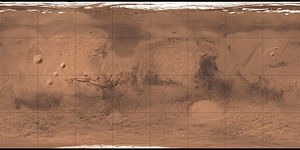Endeavor (Mars Crater)
| Endeavor Martian Crater | ||
|---|---|---|

|
||
| Endeavor Crater | ||
|
|
||
| position | 2 ° 17 ′ S , 5 ° 14 ′ W | |
| diameter | 20 km | |
| depth | 300 m | |
| history | ||
| Eponym | Endeavor in Canada | |
Endeavor Crater is an impact crater in the Meridiani Plain on Mars . It has a diameter of approx. 22 km and a depth of 300 m. Since late 2008, it has been the target of the rover Opportunity , which reached the crater in August 2011.
It was originally named by the Opportunity team after the ship Endeavor , just as most of the craters were named after ships from well-known voyages of discovery during the mission . However, names of structures over 10 km in diameter are given by the International Astronomical Union . Larger craters must be named after famous people or cities according to their specifications. That is why the crater officially bears the name of the city of Endeavor , a town in the Canadian province of Saskatchewan .
Exploration
After the Rover Opportunity completed its investigation of the Victoria Crater in August 2008 , the Endeavor Crater was selected as a new long-term target. Observations from Mars orbit showed that sheet silicates can be found there on the surface. These silicates are a sure sign of water exposure. The direct distance from Victoria Crater is 12 km. However, as an attempt was made to avoid problematic terrain such as large sand dunes, a longer route of around 19 km was chosen.
On March 7, 2009 ( Sol 1820) Opportunity was able to see the crater rim of Endeavor for the first time ; the rim was reached on August 9, 2011, as planned near Cape York . This hill is surrounded by hydrated bedrock. From there it is planned to drive along the edge hill Solander Point to Cape Tribulation . There the layered silicates ( clay minerals ) were discovered, which will then be examined more closely.
The scientific team has named the visible features after places that were visited by James Cook with his ship HMS Endeavor during his first South Seas voyage 1768–1771 .
geology
With the help of the MRO space probe , the geology of the crater rim could be analyzed from orbit. In the adjacent section, a small part of the western edge of the crater is shown. Here the interrupted crater wall leads along in a north-south direction. This consists of basalt (shown in blue) and clay minerals (green). These rock occurrences are believed to be older than the sulphate deposits that Opportunity has investigated in the Meridiani Plain to date.
Layered silicates are formed in aqueous and non-acidic environments. Such minerals have not yet been examined by a land mission . The layered silicates in Endeavor are associated with layered rocks in the crater rim. These rocks could have formed in regional or global processes under the influence of water, and this at a time that began before the formation of sulphates in an acidic environment, which the Mars rover Opportunity has so far discovered while studying rocks in the Meridiani Plain.
Endeavor Crater was largely covered by sulphate-rich sediments that formed in the Late and Early Noachian Era , so it must have formed before the sediments. Some parts of its eroded edge protrude over these sediments, exposing older layers.
The investigations with the space probe could help to understand the conditions under which the sheet silicates formed.
See also
swell
- NASA: Press Release (English)
- NASA: Press Release (English)
- ↑ JJ Wray, EZ Noe Dobrea, RE Arvidson et. al: Phyllosilicates and sulfates at Endeavor Crater, Meridiani Planum, Mars . In: GEOPHYSICAL RESEARCH LETTERS . tape 36 , November 4, 2009, doi : 10.1029 / 2009GL040734 ( brown.edu [PDF; accessed December 31, 2010]).

